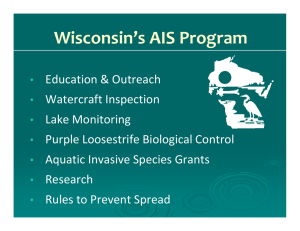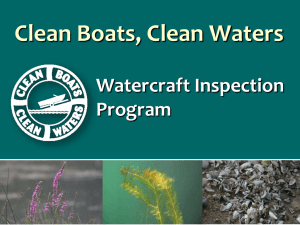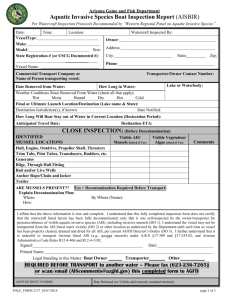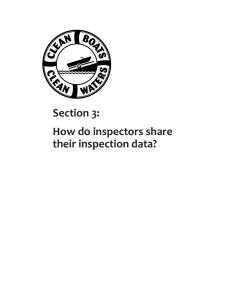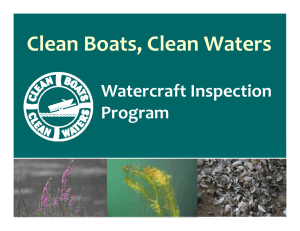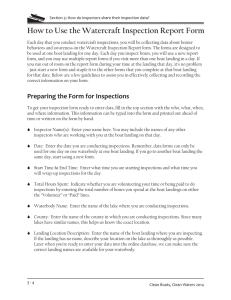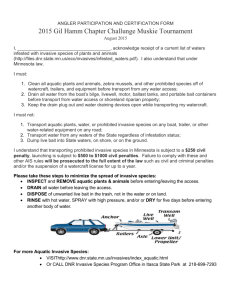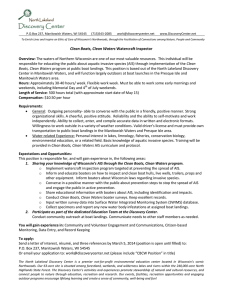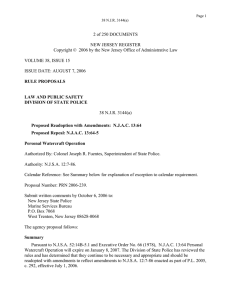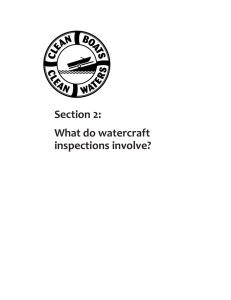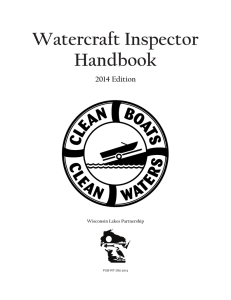Clean Boats Clean Waters Clean Boats, Clean Waters Volunteer Watercraft Inspection Program
advertisement
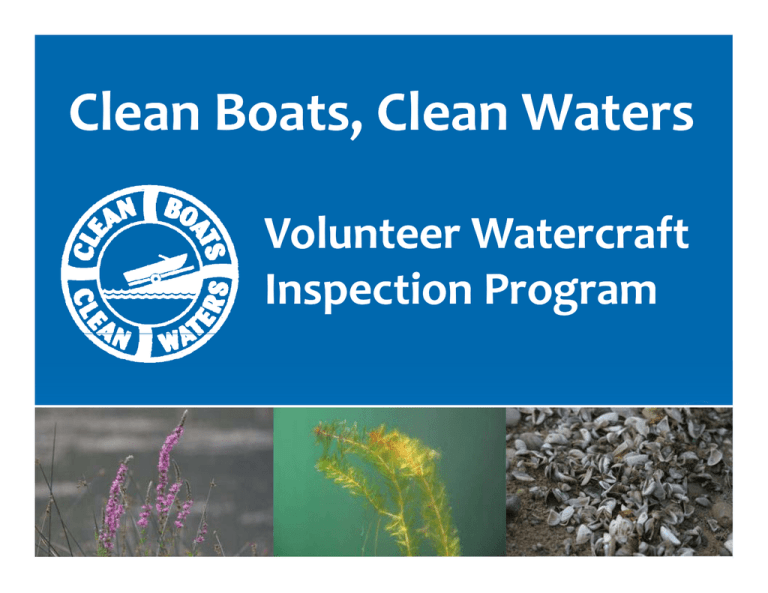
Clean Boats Clean Waters Clean Boats, Clean Waters Volunteer Watercraft Inspection Program Wisconsin: A Gathering of Waters ¾ 11 190 square miles of water 11,190 square miles of water ¾ 15,081 lakes ¾ 43,000 miles of rivers and streams ¾ 5.3 million acres of wetlands ¾ 6.4 million acres of Great Lakes ¾ Estimated 1 million boats on waters each year! y Welcome to the Challenge! What you really need y y to know about AIS… Volunteers DO make a difference! Why watercraft inspection? Getting Started: Volunteer Duties g ¾ Inform and educate boaters ¾ Perform watercraft inspections ¾ Collect and report watercraft data Recruiting Volunteers g ¾ Commit volunteers with: newsletters, phone call, personal visits ¾ Develop a recruiting/training packet ¾ Appoint a coordinator to schedule and organize schedule and organize volunteer hours ¾ Select optimum days and high S l t ti d d hi h use landing sites Manitowoc Co. Lakes Council Retaining Volunteers ¾ Generous thank‐you! ¾ Offer supplies • • • • T‐shirt & hat Water Sun tan lotion Bug spray ¾ Publish volunteer names ¾ Advertise accomplishments Advertise accomplishments ¾ Awards and certificates ¾ Celebrate! Waupaca Chain Of Lakes Materials Needed 9 CBCW T‐shirt or sticker 9 Clipboard & pencil g p 9 Boat landing script 9 Watercraft Inspection form & Check Point List Check Point 9 Tool kit 9 List of lakes identified with AIS List of lakes identified with AIS 9 Plastic bags & marker 9 Cell phone & local contacts Cell phone & local contacts 9 Camera and Violation form Boat Landing Message ¾ Discuss prevention steps: p p z Inspect and remove aquatic plants and animals z Drain all water from boat and equipment z Dispose of unwanted bait in trash of unwanted bait in trash z z Rinse boat and equipment with hot/high pressure water OR Dryy boat for at least 5 days y Boat Landing Message g g ¾ Discuss the illegal to launch g law ‐ Wisconsin Statute 30.715(2)(3) ¾ Perform a watercraft check – Involve boater! ¾ Offer a decal‐commitment and prompt and prompt ¾ Repeat boaters? Three Step Approach ¾ The SOFT touch: z Discuss the prevention steps ¾ An assertive approach: z Help remove plants, get a sample and location of prior waterbody ¾ The STRONGEST approach: z Violation report form, picture, registration numbers Collecting Data ¾ ¾ ¾ Efforts for 2008: 12,200 volunteer hours 54,115 boat inspections 113,601 people contacted ¾ Gather information on Gather information on boater behaviors Determine traveling g patterns of recreational users Inventory boater knowledge of invasive species Useful data for lake planning grants, local ordinance reviews di i Boaters Who Reported Taking P Prevention i Steps S 2004 2004-2007 2007 Percentt of Boa aters 100% 91% 80% 60% 70% 72% 2005 2006 40% 0% 20% 0% 12% 2004 Year 2007 Boaters Aware of WI Stat. 30.715(2)(3) 2004‐2008 100% 90% 91% 2007 2008 84% 80% Perce ent of Boatters 68% 60% 40% 21% 20% 0% 2004 2005 2006 Prevention Steps Taken by Boaters in 2008 100% (After Their Last Boating Trip) (After Their Last Boating Trip) 93% 91% Percent of Bo oaters 80% 69% 68% 57% 60% 40% 20% 0% Inspected and Removed Plants Removed Plants Drained Water Disposed of Bait Did Not Leave Washed Landing with Live Equipment Landing with Live Equipment or Let or Let Fish Dry for 5 Days Prevention Steps Handling a Violation ¾ Do your homework before… How to Change Boater Behavior ¾ Educational materials Educational materials ¾ Prompts (decals, stickers) ¾ Personal contacts ¾ Modeling behavior ¾ Social diffusion Steps for an Effective Watercraft Inspection Program ¾ Determine boat landing ownership ¾ Maintain effective inspection hours Maintain effective inspection hours ¾ Develop a plan to recruit, train, & retain volunteers l ¾ Wear Clean Boats, Clean Waters t‐shirts or stickers ¾ Develop an accurate and concise message Develop an accurate and concise message Steps for an Effective Watercraft Inspection Program ¾ Know what educational materials are available and who to contact ¾ Keep and report watercraft inspection records ¾ Report any suspect specimens Report any suspect specimens ¾ Encourage others! The major influence on our attitudes and and behavior is not the media, but behavior is not the media but rather our contact with other people. “ “Fostering Sustainable Behavior” Doug McKenzie‐ “Fostering Sustainable Behavior” Doug McKenzie bl h ” ‐Mohr, William Smith h ll h CBCW Resources & Gear ¾ Resources z z z z Watercraft Inspection Manual Tool kit DVDs Web site: www.uwsp.edu/cnr/uwexlakes/CBCW p ¾ Gear z z z z TT‐shirts hi t Aprons Hats Stickers Please Contact Us! ¾ For more information contact: EErin Henegar i H 715‐346‐4978 ehenegar@uwsp.edu ¾ To order t‐shirts, kits, handbooks, aprons, or hats, contact Erin. ¾ To download materials & presentations, search d l d l h for volunteers, etc., visit our web site: www.uwsp.edu/cnr/uwexlakes/CBCW d / / l k /CBCW Interactive Training ? ? ?
